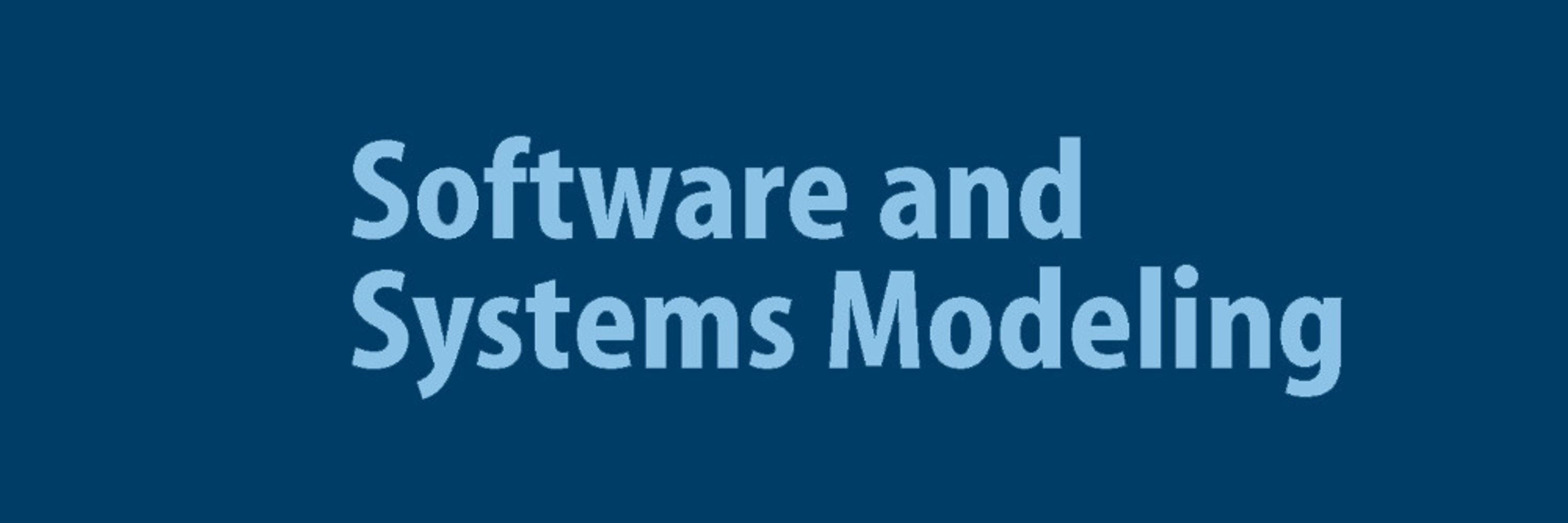
#SoSyM is launching a rolling theme section on Engineering Digital Twins, directly linked to the International Conference on Engineering Digital Twins (#EDTconf).
➡️ Details in the CfP: www.sosym.org/theme_sectio...
LINDDUN MAESTRO: an architecture framework for privacy threat modeling
Dimitri Van Landuyt, Laurens Sion & Wouter Joosen
doi.org/10.1007/s102...

LINDDUN MAESTRO: an architecture framework for privacy threat modeling
Dimitri Van Landuyt, Laurens Sion & Wouter Joosen
doi.org/10.1007/s102...
EvolveDB: evolving relational database schemas in a model-driven way
Torben Eckwert, Michael Guckert & Gabriele Taentzer
doi.org/10.1007/s102...

EvolveDB: evolving relational database schemas in a model-driven way
Torben Eckwert, Michael Guckert & Gabriele Taentzer
doi.org/10.1007/s102...

A method for digital business ecosystem design: evaluation of two cases in the maritime dataspaces
Chen Hsi Tsai, Ben Hellmanzik, Jelena Zdravkovic, Janis Stirna & Kurt Sandkuhl
doi.org/10.1007/s102...

A method for digital business ecosystem design: evaluation of two cases in the maritime dataspaces
Chen Hsi Tsai, Ben Hellmanzik, Jelena Zdravkovic, Janis Stirna & Kurt Sandkuhl
doi.org/10.1007/s102...
Reviewing uses of regulatory compliance monitoring
Finn Klessascheck & Luise Pufahl
doi.org/10.1007/s102...

Reviewing uses of regulatory compliance monitoring
Finn Klessascheck & Luise Pufahl
doi.org/10.1007/s102...
Flexible and sound: Synthesis Miner
Tsung-Hao Huang, Enzo Schneider, Marco Pegoraro & Wil M. P. van der Aalst
doi.org/10.1007/s102...

Flexible and sound: Synthesis Miner
Tsung-Hao Huang, Enzo Schneider, Marco Pegoraro & Wil M. P. van der Aalst
doi.org/10.1007/s102...
In 2025, the following articles were presented: 2025.models-conf.com/track/models...
Find out more about them here: www.sosym.org/journal_first/

In 2025, the following articles were presented: 2025.models-conf.com/track/models...
Find out more about them here: www.sosym.org/journal_first/
Model-based stochastic analysis with probabilistic graph query evaluation
Máté Földiák, Kristóf Marussy & Dániel Varró
doi.org/10.1007/s102...

Model-based stochastic analysis with probabilistic graph query evaluation
Máté Földiák, Kristóf Marussy & Dániel Varró
doi.org/10.1007/s102...
📅 Deadlines:
10-Dec-2025: intent to submit
15-Jan-2026: submission
More details in the CfP: www.sosym.org/theme_sectio...

📅 Deadlines:
10-Dec-2025: intent to submit
15-Jan-2026: submission
More details in the CfP: www.sosym.org/theme_sectio...


ATM: a Logic for Quantitative Security Properties on Attack Trees
Stefano M. Nicoletti, Milan Lopuhaä-Zwakenberg, E. Moritz Hahn & Mariëlle Stoelinga
doi.org/10.1007/s102...

ATM: a Logic for Quantitative Security Properties on Attack Trees
Stefano M. Nicoletti, Milan Lopuhaä-Zwakenberg, E. Moritz Hahn & Mariëlle Stoelinga
doi.org/10.1007/s102...
A devops framework for the systematic engineering and evolution of digital twins for built assets
Sara Aissat, Jonathan Beaulieu, Érik Poirier, Ali Motamedi, Julien Gascon-Samson & Francis Bordeleau
doi.org/10.1007/s102...

A devops framework for the systematic engineering and evolution of digital twins for built assets
Sara Aissat, Jonathan Beaulieu, Érik Poirier, Ali Motamedi, Julien Gascon-Samson & Francis Bordeleau
doi.org/10.1007/s102...
An approach to generating attack graphs and analyzing threats based on CAPEC and ATT&CK matrix
Changlan Fu, He Zhang & Yaochen Zhou
doi.org/10.1007/s102...

An approach to generating attack graphs and analyzing threats based on CAPEC and ATT&CK matrix
Changlan Fu, He Zhang & Yaochen Zhou
doi.org/10.1007/s102...
Automated construction of predicate abstractions for smart contract validation
Javier Godoy, Eden Torres, Juan P. Galeotti, Diego Garbervetsky & Sebastian Uchitel
doi.org/10.1007/s102...

Automated construction of predicate abstractions for smart contract validation
Javier Godoy, Eden Torres, Juan P. Galeotti, Diego Garbervetsky & Sebastian Uchitel
doi.org/10.1007/s102...
Merlin - modEl-guided reinforcement learnINg for automated testing of endless runner games
Nigar Azhar Butt, Muhammad Uzair Khan, Muhammad Zohaib Iqbal & Atif Aftab Jilani
doi.org/10.1007/s102...

Merlin - modEl-guided reinforcement learnINg for automated testing of endless runner games
Nigar Azhar Butt, Muhammad Uzair Khan, Muhammad Zohaib Iqbal & Atif Aftab Jilani
doi.org/10.1007/s102...
Using biometric data to improve our understanding and support of business process model comprehension
John Krogstie & Kshitij Sharma
doi.org/10.1007/s102...

Using biometric data to improve our understanding and support of business process model comprehension
John Krogstie & Kshitij Sharma
doi.org/10.1007/s102...
Enhancing explainability in process variant analysis: a framework for detecting and interpreting control-flow changes
Ali Norouzifar, Majid Rafiei, Marcus Dees & Wil van der Aalst
doi.org/10.1007/s102...

Enhancing explainability in process variant analysis: a framework for detecting and interpreting control-flow changes
Ali Norouzifar, Majid Rafiei, Marcus Dees & Wil van der Aalst
doi.org/10.1007/s102...
Modeling in Jjodel: towards bridging complexity and usability in model-driven engineering
Antonio Bucchiarone, Juri Di Rocco, Damiano Di Vincenzo & Alfonso Pierantonio
doi.org/10.1007/s102...

Modeling in Jjodel: towards bridging complexity and usability in model-driven engineering
Antonio Bucchiarone, Juri Di Rocco, Damiano Di Vincenzo & Alfonso Pierantonio
doi.org/10.1007/s102...
#SoSyM is launching a rolling theme section on Engineering Digital Twins, directly linked to the International Conference on Engineering Digital Twins (#EDTconf).
➡️ Details in the CfP: www.sosym.org/theme_sectio...
#SoSyM is launching a rolling theme section on Engineering Digital Twins, directly linked to the International Conference on Engineering Digital Twins (#EDTconf).
➡️ Details in the CfP: www.sosym.org/theme_sectio...



Model-driven engineering of SAP core data services - the bigER2CDS modeling tool
Gallus Huber & Dominik Bork
doi.org/10.1007/s102...

Model-driven engineering of SAP core data services - the bigER2CDS modeling tool
Gallus Huber & Dominik Bork
doi.org/10.1007/s102...


